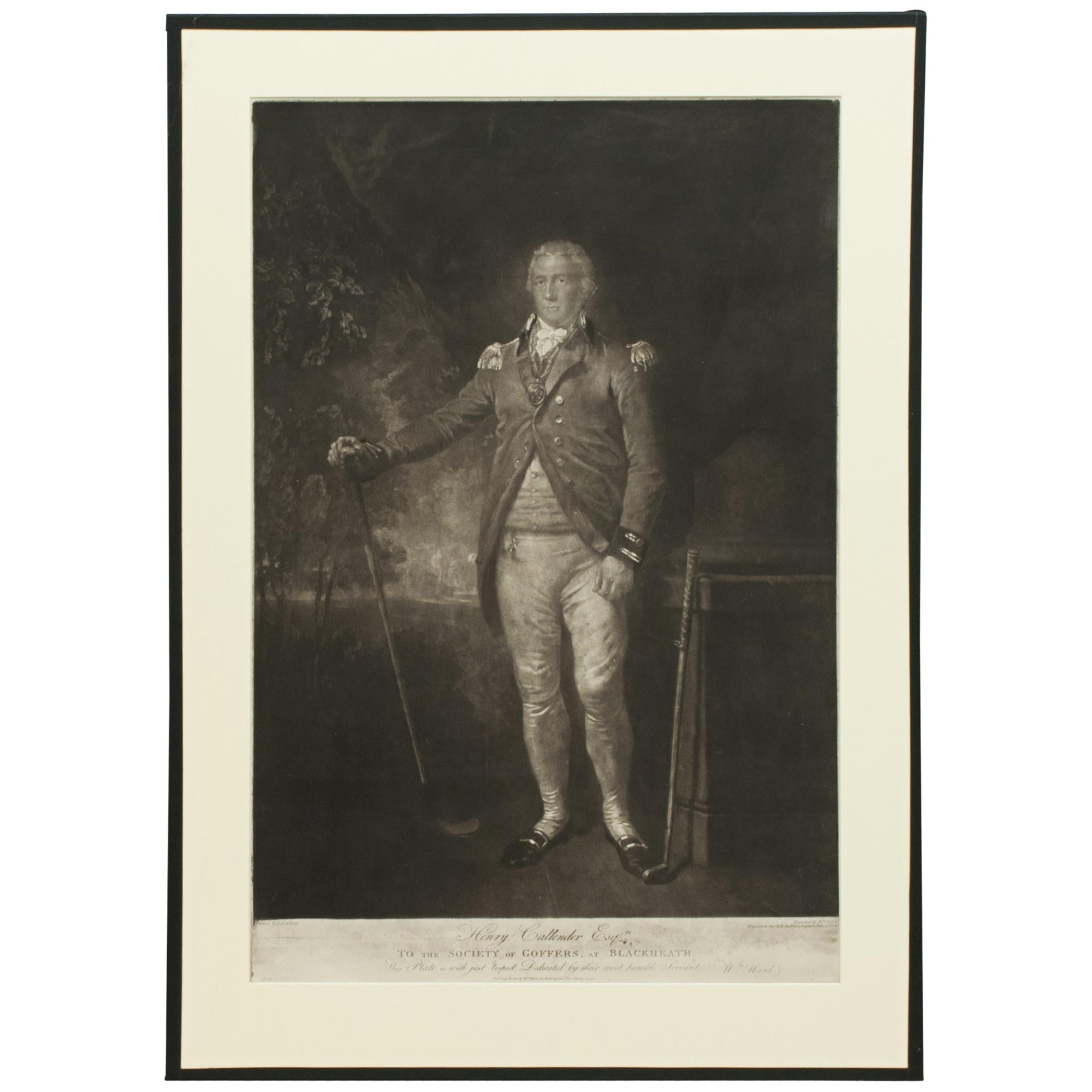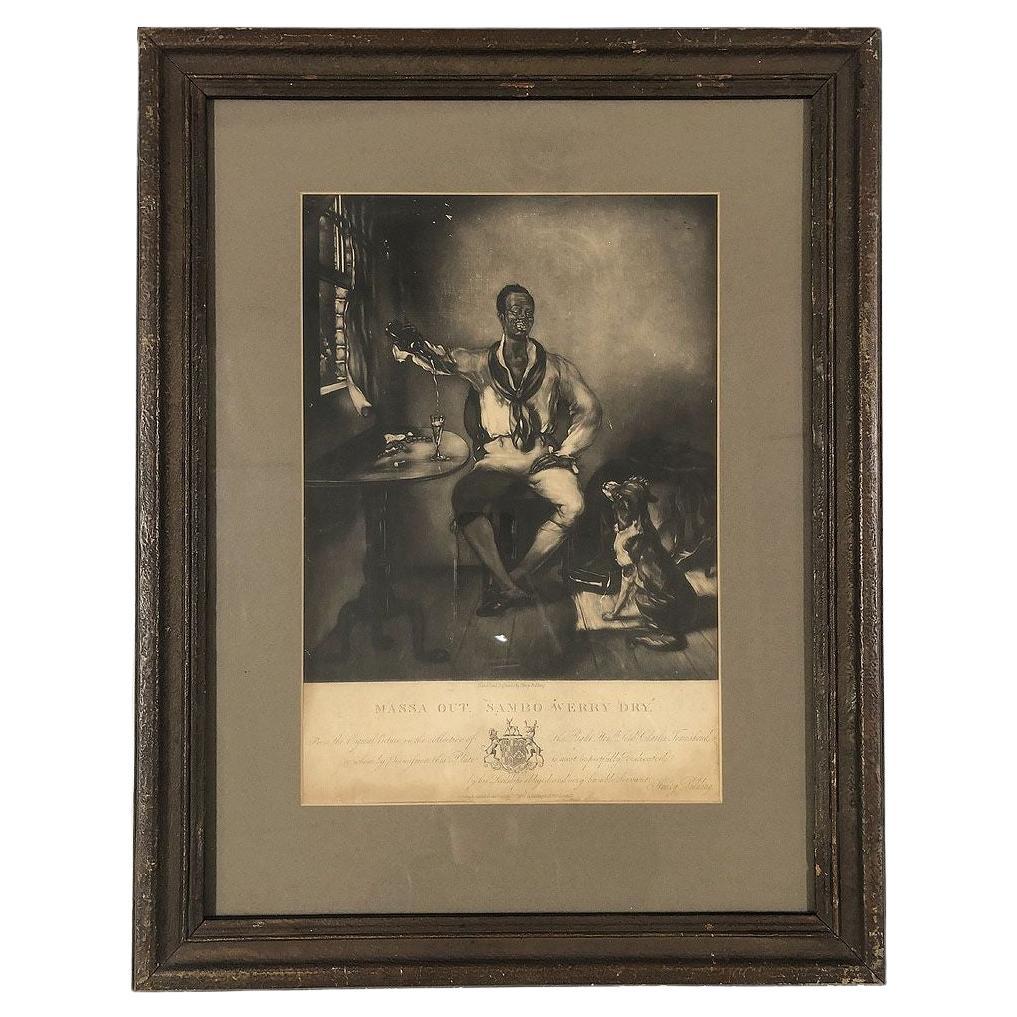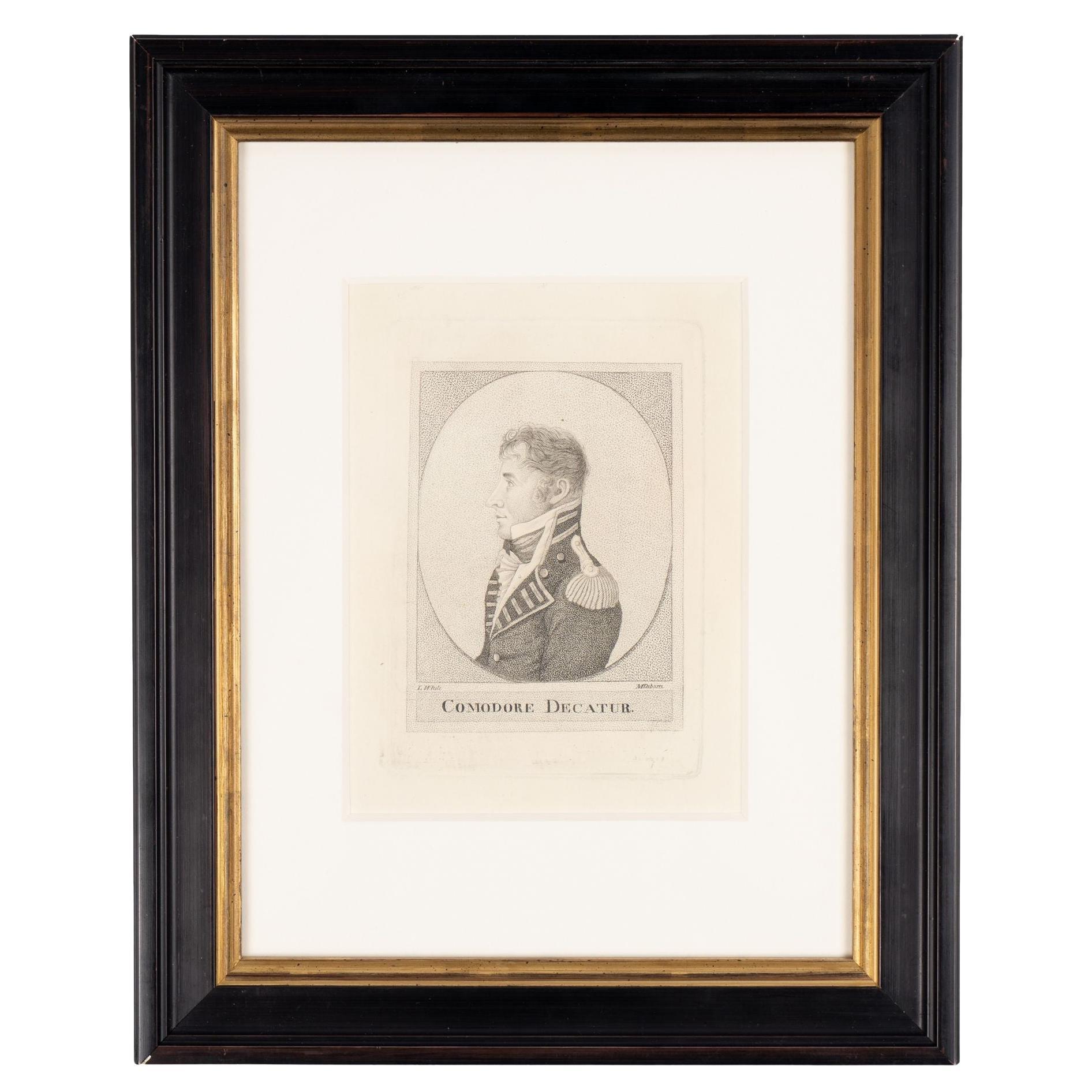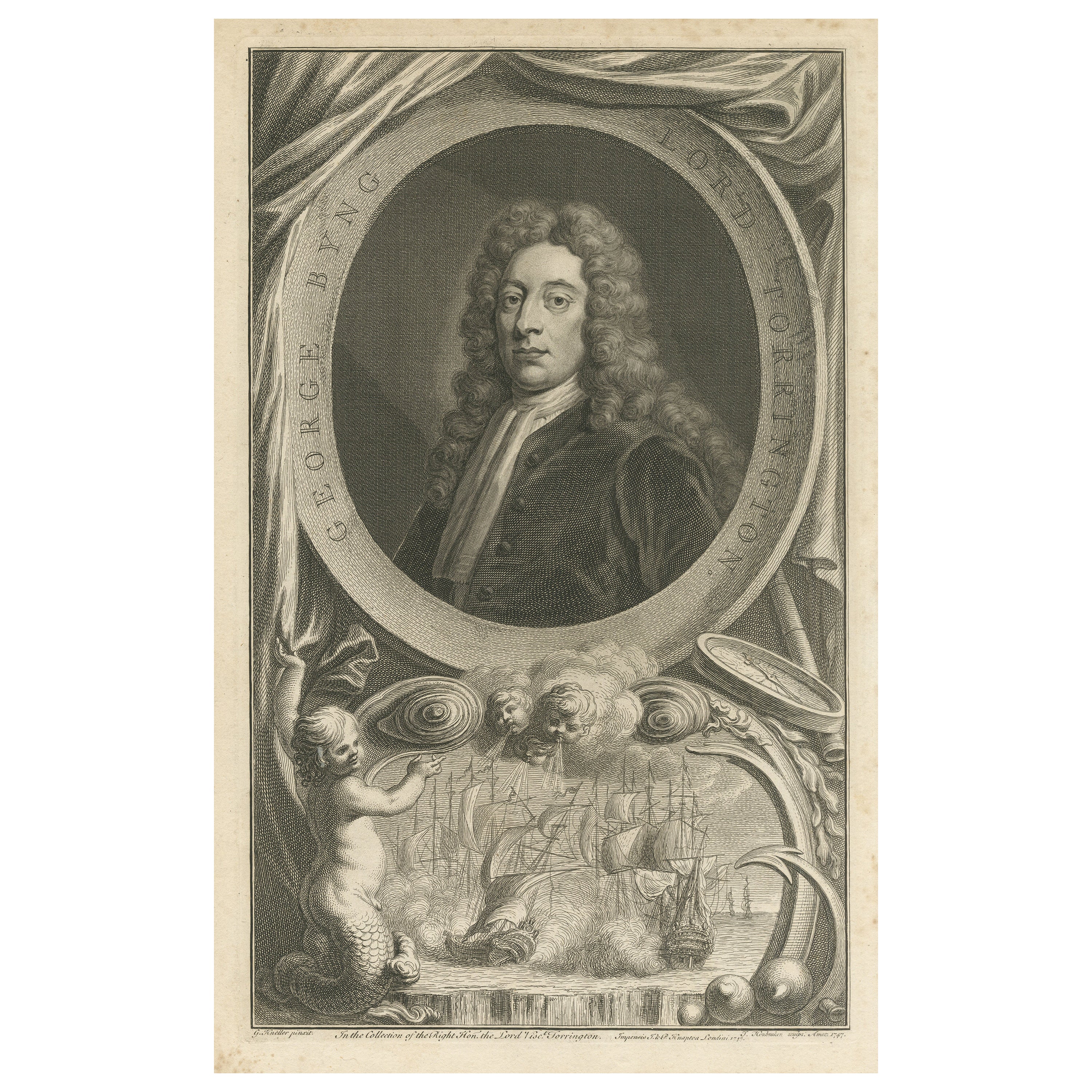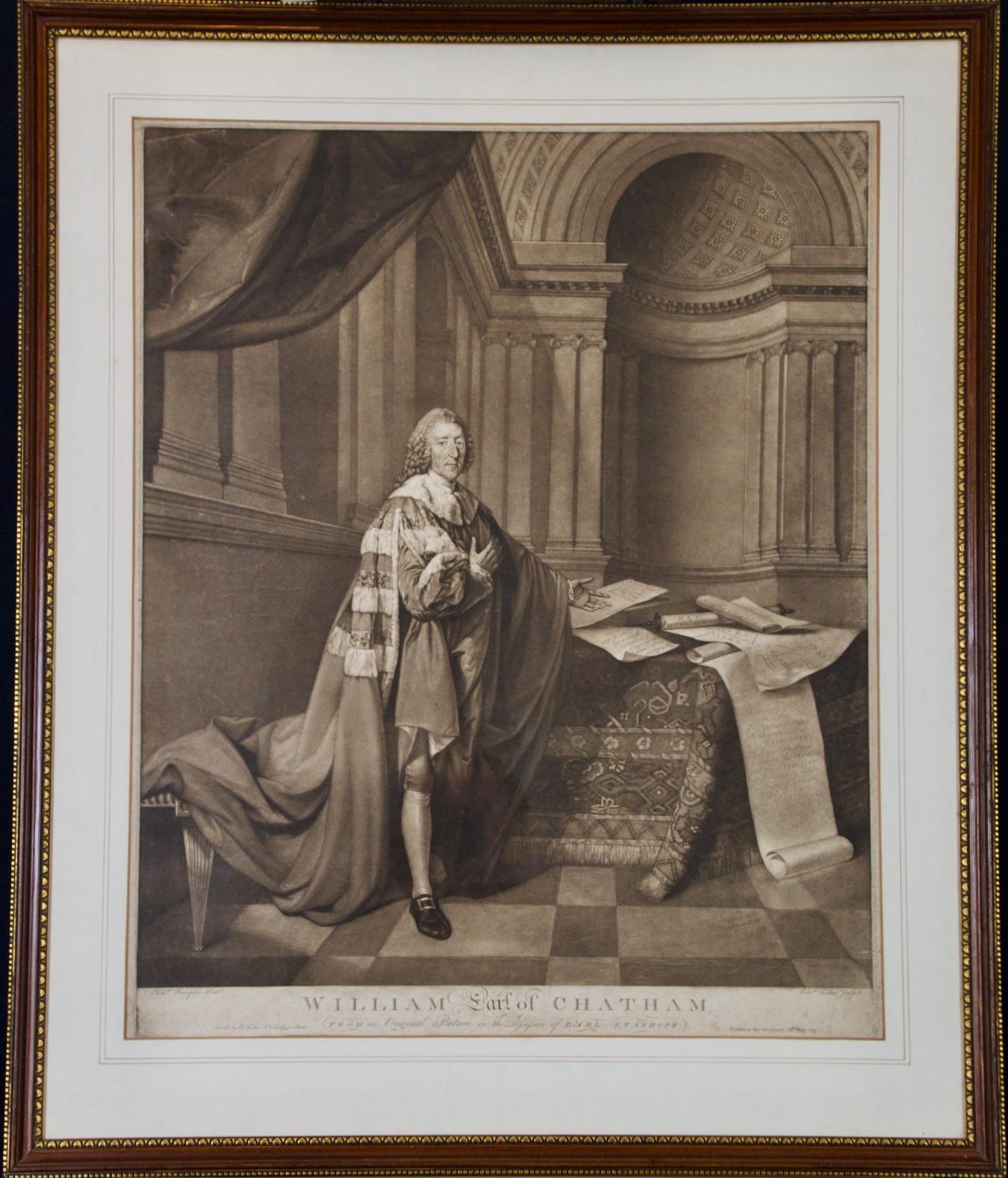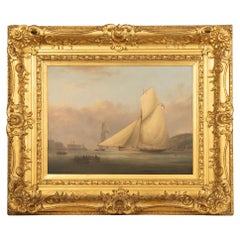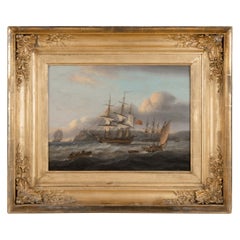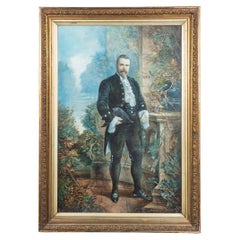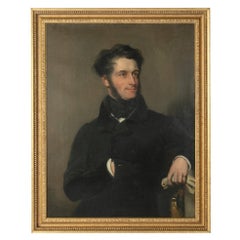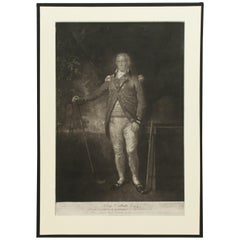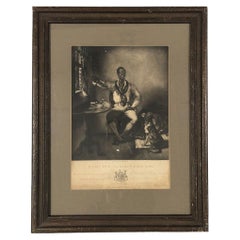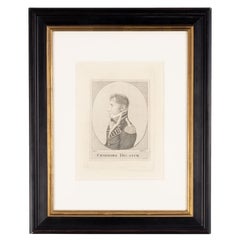Items Similar to Portrait Mezzotint of Admiral Viscount Duncan
Want more images or videos?
Request additional images or videos from the seller
1 of 5
Portrait Mezzotint of Admiral Viscount Duncan
$7,961.48
£5,775
€6,743.73
CA$11,008.16
A$12,085.59
CHF 6,305.08
MX$146,252.47
NOK 79,024.37
SEK 74,461.73
DKK 50,340.16
About the Item
This fine impression of the celebrated print engraved by mezzotint engraver John Raphael Smith after a painting by Henry Danloux shows the subject on the deck of a ship in the heat of the Battle Camperdown. It is framed in an ornate giltwood frame with a paper label on the reverse showing a coat of arms flanked by the inscription ‘Admiral Lord Viscount Duncan when Victorious off Camperdown, is by permission most humbly dedicated to the Hon. Miss Jane Duncan by her most obedient Servant H.P.Danloux London. Published by H. P. Danloux No 11 Charles Street, Middlesex Hospital. May 1 1800.’ English, circa 1800.
This image was described in John Chaloner Smith’s landmark catalogue of British Mezzotinto Portraits in 1878 as follows:
Admiral Viscount Duncan (1731-1804) was the victor of the Battle of Camperdown. Born into a naval family, he served under Captain Robert Haldane and Admiral Keppel. He was promoted to commander in 1759, having already been present at many important battles in the mid to late 1750s. He achieved his final rank as Commander-in-Chief of the North Sea by 1795. Duncan’s most famous victory was that at Camperdown, which ended in a total defeat of the Dutch fleet, despite heavy losses on both sides. The action was considered to be Britain’s most comprehensive naval victory to date, and Duncan returned home as a hero and sat for several portraits in the coming months. He retired from active service in 1800, dying unexpectedly in 1804.
Henry (Henri-Pierre) Danloux was born in France and specialised in royal and aristocratic portraits until forced to flee to England in 1792 as the Revolution took hold. Once settled in Britain, Danloux’s studio was in London, but he undertook numerous trips to Edinburgh to see the French Royal family in exile in Holyrood House and continued to paint them and members of the Scottish aristocracy and nobility amongst whom was Admiral Duncan.
- Creator:John Raphael Smith (Artist)
- Dimensions:Height: 29 in (73.66 cm)Width: 22.75 in (57.79 cm)Depth: 0.1 in (2.54 mm)
- Materials and Techniques:
- Place of Origin:
- Period:
- Date of Manufacture:circa 1800
- Condition:Wear consistent with age and use.
- Seller Location:Lymington, GB
- Reference Number:1stDibs: LU973029541122
About the Seller
5.0
Recognized Seller
These prestigious sellers are industry leaders and represent the highest echelon for item quality and design.
Gold Seller
Premium sellers maintaining a 4.3+ rating and 24-hour response times
Established in 1982
1stDibs seller since 2013
135 sales on 1stDibs
Typical response time: 2 hours
Associations
LAPADA - The Association of Arts & Antiques Dealers
- ShippingRetrieving quote...Shipping from: Lymington, United Kingdom
- Return Policy
Authenticity Guarantee
In the unlikely event there’s an issue with an item’s authenticity, contact us within 1 year for a full refund. DetailsMoney-Back Guarantee
If your item is not as described, is damaged in transit, or does not arrive, contact us within 7 days for a full refund. Details24-Hour Cancellation
You have a 24-hour grace period in which to reconsider your purchase, with no questions asked.Vetted Professional Sellers
Our world-class sellers must adhere to strict standards for service and quality, maintaining the integrity of our listings.Price-Match Guarantee
If you find that a seller listed the same item for a lower price elsewhere, we’ll match it.Trusted Global Delivery
Our best-in-class carrier network provides specialized shipping options worldwide, including custom delivery.More From This Seller
View AllAn oil on canvas of William Paget, Marquess of Anglesey’s yacht Pearl by Nicolas
Located in Lymington, Hampshire
An oil on canvas of William Paget, Marquess of Anglesey’s yacht Pearl by Nicolas Condy, the reverse with a paper trade label for ‘Akermann & Co, prepared millboards, pastels, canvass...
Category
Antique Mid-19th Century English Paintings
Materials
Canvas, Paint
Thomas Luny, Hms Bellerophon Leaving Torbay with the Defeated Emperor Napoleon
Located in Lymington, Hampshire
Thomas Luny (British, 1759-1837) HMS Bellerophon leaving Torbay with the defeated Emperor Napoleon aboard, 26th July 1815, this oil on panel shows the crew manning the yards to bring in the sails, having just dropped anchor in Torbay, with another battleship anchored astern and a further ship under sail in the distance, the foreground with working boats approaching, signed and dated ‘Luny 1827’(lower left). In the original gilt-wood frame.
Provenance: Private collection, UK.
Footnote: Despite a service career as illustrious as any fighting ship...
Category
Antique 19th Century British Paintings
Materials
Paint
A large portrait of Provost Samuel Leckie by William A. Donnelly 1901
Located in Lymington, Hampshire
A large portrait of Provost Samuel Leckie as he was presented to Queen Victoria in 1897, William A. Donnelly, 1901, gouache and watercolour showing a large bearded man in court dress...
Category
Early 20th Century English Paintings
Materials
Paint
Andrew Morton R. A.: Captain George Treweeke Scobell, 1840
By Andrew Morton
Located in Lymington, Hampshire
This oil on canvas half portrait shows a bearded Capt. G.T. Scobell looking to his left and wearing a black frock coat with a high collar, a white shirt and wide cravat. His right ha...
Category
Antique 19th Century English Paintings
Materials
Canvas, Paint
A framed plaster portrait plaque of the Glasgow Reformist MP James Oswald, signe
Located in Lymington, Hampshire
A framed plaster portrait plaque of the Glasgow Reformist MP James Oswald, signed and dated Carlo Marochetti, 1842, of circular form, shown facing to the right within a black border and the original glazed giltwood frame.
Another version of this plaque is in the collection of Glasgow Museums and can be seen on the Art UK website
James Oswald (1779-1853) was a successful Glasgow merchant who later inherited various landed estates due to the early death of his cousin. Oswald was one of the first members of the Glasgow Bank when it was established in 1809. He traded largely in cotton and other raw textiles and in his spare time he commanded the Glasgow branch of the volunteer mounted Yeomanry. It was his political career however that captured the hearts of many of his countrymen and led to his eventually being immortalised in sculptural form.
The Liberal Party MP for Glasgow from 1832-1837, Oswald was a staunch opponent of Sir Robert Peel...
Category
Antique 1840s Decorative Art
Materials
Plaster
Original Gelatine Print of a Gentleman’s Steam Yacht
Located in Lymington, Hampshire
An original gelatine print of a gentleman’s steam yacht steaming eastwards through the Solent by Wm U Kirk. Impressed to the right hand side.
Circa 1900
Category
Antique Early 1900s English Nautical Objects
Materials
Paper
You May Also Like
Antique Golf Engraving, Henry Callender ESQ, Golf Mezzotint
Located in Oxfordshire, GB
Golf mezzotint of 'Henry Callender Esq' (Captain of the society of Golfers at Blackheath) after Lemuel Francis Abbott (1760-1803).
Henry Callend...
Category
Antique 1810s British Sporting Art Sports Equipment and Memorabilia
Materials
Paper
Henry MacBeth Raeburn RA RE (1860-1947) - Mezzotint, General Hay MacDowall
Located in Corsham, GB
A charming mezzontint after the portrait by Henry MacBeth Raeburn depicting General Hay MacDowall. Hay MacDowall was a Scottish officer in the British Army who was the sixth General ...
Category
Early 20th Century Portrait Prints
Materials
Mezzotint
1828 Egnlish Massa Out “Sambo Werry Dry” Mezzotint Etching By Henry Pidding
Located in Van Nuys, CA
Late Georgian period Mezzotint Etching print By English Artist Henry Pidding titled Massa Out “Sambo Werry Dry”. The print features a young man seated by a table on which are keys ma...
Category
Antique 1820s Romantic Drawings
Materials
Paper
$1,377 Sale Price
40% Off
Commodore Decatur by Milo Osborn, 1820
Located in Kenilworth, IL
American engraving of Commodore Stephen Decatur printed on laid paper. Decatur was the naval hero of the War of 1812 and the Battle of Tripoli. His house is a National Historic Site ...
Category
Antique 1820s American Prints
Materials
Paper
Antique Portrait of Admiral of the Fleet George Byng, 1st Viscount Torrington
By Jacobus Houbraken
Located in Langweer, NL
Antique portrait titled 'George Byng Lord Torrington'. Admiral of the Fleet George Byng, 1st Viscount Torrington, KB, PC (27 January 1663 – 17 January 1733), of Southill Park in Bedfordshire, was a Royal Navy officer and statesman. While still a lieutenant, he delivered a letter from various captains to Prince William of Orange, who had just landed at Torbay, assuring the Prince of the captains' support; the Prince gave Byng a response which ultimately led to the Royal Navy switching allegiance to the Prince and the Glorious Revolution...
Category
Antique Mid-18th Century Prints
Materials
Paper
$320 Sale Price
30% Off
Portrait of William Pitt, Earl of Chatham: Rare Framed Mezzotint after Brompton
By Edward Fisher
Located in Alamo, CA
This is a large framed very rare hand-colored copperplate mezzotint engraved portrait of William Pitt, the Elder, 1st Earl of Chatham by Edward Fisher, published in London in 1779 after a painting by Richard Brompton. Pitt is depicted attired in a flowing regal appearing cape, standing in an ornate room with his left hand outstretched over a serious of manuscripts and scrolls that are laying on a table or desk to his left. The table is covered by a beautiful oriental carpet. The manuscripts include the Magna Carta, a map of the colonies, including Long Island and Staten Island, and papers entitled "A Plan for the Reconciliation between Great Britain and the Colonies", "A Motion Made in 1775 for the Recall of Troops from Boston", "A Provisional Act for Settling the Troubles in America Offered to the House of Lords in 1775", and "It is doing Nothing to repeal a few Scraps of Paper or Pieces of Parchment called Acts of Parliament. But our Business is to repeal the Ill-Will and the Animosity unfortunately now subsisting between Great Britain and North America". This engraving is held by the British Museum and the British Royal Collection Trust.
This large framed mezzotint engraving is presented in a brown wood frame with gold-colored beaded inner and outer trim, and a cream-colored French mat. The frame measures 31.63" high by 26.63" wide by 0.75" deep. There are three short tears along the right edge and mild creasing in the left upper, left lower and right lower corners. It is otherwise in very good condition.
William Pitt (1708-1778) was a member of the British parliament from 1735 to 1761 and prime minister from 1766 to 1768. Pitt was an advocate for the American colonies leading up to the War of Independence. He called for an amiable relationship between Great Britain and the colonies and opposed the Stamp Act and military action in America. He advocated for a withdrawal of English troops from Boston in 1775 and the settling of troubles in America, as two of his manuscripts on the table outline. Pitt's colleague, Lord Shelburne (later the Marquess of Lansdowne) shared his sympathies and after Pitt's death, signed a peace treaty with the United States in 1782.
The American city of Pittsburgh, Pennsylvania is named for William Pitt, the Elder. The name originated when the conflict between the British and French over territorial claims in the Northeast were settled in 1758. General John Forbes and his British army, supported by the American colonial troops, expelled the French from Fort Duquesne (which had been constructed by the French in 1754). Forbes re-named the site for William Pitt the Elder, who at the time was a British statesman. The earliest known reference to the new name, Pittsburgh, is in a letter sent from General John Forbes to Pitt, dated November 27, 1758. Pitt's son, William Pitt, the Younger, like his father, also served as British Prime Minister.
Edward Fisher (1730-1785) was born in Ireland in 1730. He was originally a hatter, but learned engraving in London. He became a member of the Incorporated Society of Artists in 1766, and exhibited there fourteen times between 1761 and 1776. He engraved more than sixty portraits. In addition to this portrait of William Pitt, Earl of Chatham, after Richard Brompton he engraved several portraits after Brompton, including George, Earl of Albemarle, as well as engraved portraits after paintings by Joshua Reynolds, including the Shakespearean actor David Garrick, Hugh, Earl of Northumberland, and Elizabeth, Countess of Northumberland and Laurence Sterne, and Hope Nursing Love, as well as Robert Brown, after Mason Chamberlin, Colley Cibber, after Jean-Baptiste van Loo, Christian VII of Denmark, after Nathaniel Dance, Simon, Earl Harcourt, after Hunter, Roger Long, after Benjamin Wilson...
Category
Late 18th Century Old Masters Portrait Prints
Materials
Mezzotint
More Ways To Browse
Jean Petit
Keyhole Cover
Kimono Chest
Large Antique Modernist
Large Bureau
Large Hand Carved Wooden Dragon
Lion Head Wall
Lockheed Constellation
Mantle Clock Carved
Mario Torres Wicker
Marquis Of Beverly Hills
Masonic Art
Match Striker Holder
Matchbox Antique
Mayflower Antique
Menorah Bronze
Metal Cabinet Drawers Industrial
Metal Lattice
